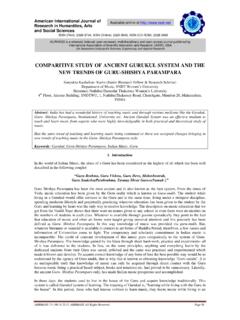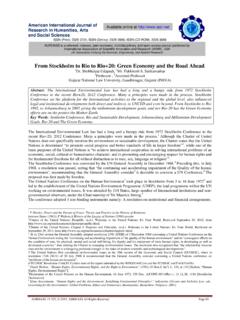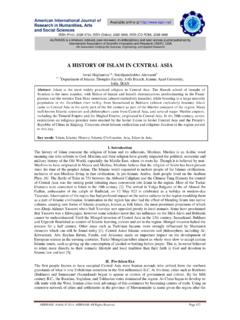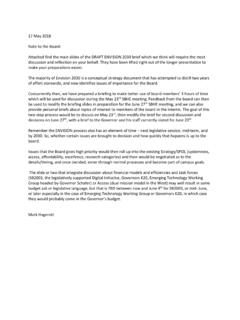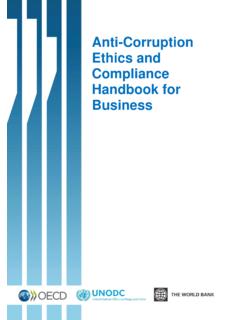Transcription of Capital Budgeting in Practice: An Explorative Study …
1 International Association of Scientific Innovation and Research (IASIR) (An Association Unifying the Sciences, Engineering, and Applied Research) International Journal of Engineering, Business and Enterprise Applications (IJEBEA) IJEBEA 15-178; 2015, IJEBEA All Rights Reserved Page 158 ISSN (Print): 2279-0020 ISSN (Online): 2279-0039 Capital Budgeting in Practice: An Explorative Study on Bangladeshi Companies Shakila Yasmin Assistant Professor Institute of Business Administration, University of Dhaka, BANGLADESH.
2 _____ Abstract: This descriptive research sheds light on Capital Budgeting practices of the companies in Bangladesh. 56 companies from different industry sectors were chosen based on convenience of data collection for survey. This is the first comprehensive Study on this topic to focus on companies in Bangladesh. Questionnaire was developed based on [7] s survey instrument. Results show that NPV and IRR are dominated methods of Capital Budgeting , however payback period (PBP) is used by large percentage of companies. In general, companies in Bangladesh are more sophisticated in terms of Capital Budgeting techniques used and risk adjustment practices thereby than companies in other emerging economies but less sophisticated than companies in developed world in terms of risk adjustment practice.
3 Influence of some factors , CEO/CFO background and company size on Capital Budgeting practices have also been explored. _____ I. Introduction This research explores the extent of using sophisticated Capital Budgeting techniques in Bangladeshi companies. Capital Budgeting is concerned about evaluation of long term investment opportunities and committing companies limited productive resources in viable opportunities to strengthen and renew their productive capabilities [15],[3]. Such commitments are kind of irreversible because reversals disturb firms economic and financial performances.
4 Therefore, success and growth of a company largely depends on its ability to effectively allocate Capital in productive use. Lacks in evaluation and decision tools to identify and exploit long term investment opportunities risk survival and hinder strategic growth of companies [6], [2]. Due to the importance of Capital Budgeting decisions, it has been a topic of research for many years. Empirical researches of the sixties exhibited primacy of payback period [11]. From early 1970s a shift happened in the Capital Budgeting techniques used by firms. More companies not only in developed world but also in other economies such as Africa started using sophisticated techniques such as NPV (net present value), IRR (internal rate of return) etc [23], [2], [16].
5 An extensive survey on companies in the USA depict that large firms heavily rely on present value (discounted cash flow) techniques and use risk adjusted discount rate (required rate of return or cost of Capital ), while small firms heavily rely on payback period method [7]. Australian firms too use CAPM and weighted average cost of Capital as the discount rate to use in present value techniques [20]. Studies on UK corporations reveals that majority of those firms use sophisticated textbook prescribed methods of Capital Budgeting which include NPV, IRR and others and formal risk appraisal methods [2], [5]. But most of the companies use firm risk rather than project specific risks in appraising investment projects and besides sophisticated discounted cash flow techniques, managers still use simple rule-of-thumb [7], [2].
6 Although companies in emerging economies such as Rwanda, Jordan, Czech Republic, Finland, India, Pakistan and others are shifting toward more sophisticated techniques of Capital Budgeting , this is true for large companies. Small companies in these economies still use payback period as the primary tool for investment evaluation. Even larger companies in many cases use discounted methods as a secondary technique. In terms of risk adjustment and estimation of cost of Capital companies in emerging economies lags behind US and UK firms [14], [18], [22], [12], [10], [15]. There has been almost no research on Capital Budgeting and/or investment evaluation techniques of the companies in Bangladesh.
7 One Study as in reference [4] determined the comparative value of different Capital Budgeting techniques on the cash flows of a particular bank branch. So this Study fails to provide any general insight about the Capital Budgeting practices of Bangladeshi companies. The Study in reference [19] conducted a survey on 50 companies from different industry sectors to assess management accounting development and practices in Bangladesh. They collected and presented data on Capital Budgeting techniques used by firms along with other management accounting measures. According to them majority firms (50% to 80%) in all industry sectors use discounted cash flow techniques and few firms use payback period for long-term investment decisions.
8 But, this Study did not have any discussion/section on risk adjustment, discount rate and other factors related to Capital Budgeting . Therefore, this exploratory research to review Capital Budgeting practices in Shakila Yasmin, International Journal of Engineering, Business and Enterprise Applications, 11(2), December 2014-February 2015, pp. 158-163 IJEBEA 15-178; 2015, IJEBEA All Rights Reserved Page 159 Bangladeshi companies is likely to bring out insights from an untapped area of corporate finance in the context of a developing economy.
9 II. Objective Broad objective of this research is to elaborate on the Capital Budgeting practices of Bangladeshi companies. For that purpose following specific objectives are pursued- Identify to what extend different Capital Budgeting techniques such as NPV, IRR, Payback Period, Discounted Payback Period, Profitability Index, Sensitivity Analysis, Scenario Analysis, Real Options Approach, and Decision Tree Analysis are used. Identify the extent of using different discount rates firm/company, divisional, project specific, country, industry, risk adjusted and other. Identify whether companies estimate their cost of Capital or use a predefined discount rate (as prescribed by corporate headquarters of multinationals or using some rule of thumb) Identify the risk factors usually taken into consideration to adjust cost of Capital and cash flows Evaluate the influence (if any) of some factors CEO/CFO background, tenure & age and company size (measured by annual sales revenue) on the Capital Budgeting practices.
10 III. Research Method A. Survey Instrument This is an exploratory research based on survey data. Previously used questionnaire developed by Graham & Harvey (2001) has been used as the survey instrument with some modifications. The questionnaire was first pilot tested on 3 companies to make sure that respondents understand the information solicited in the questionnaire. Based on recommendations of the respondents of pilot survey some adjustments (rephrasing) were made on the questionnaire. B. Sample The questionnaire has been handed in person to finance managers of 56 companies in different industry sectors 50 of them returned filled in questionnaires.

